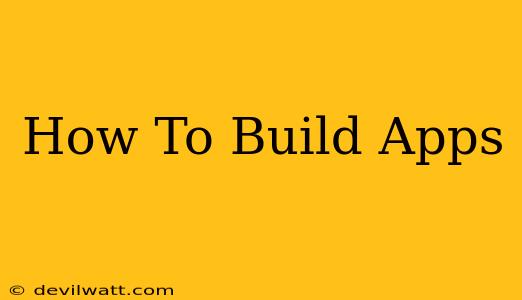So, you want to build apps? That's fantastic! The app development world is booming, offering incredible opportunities for creativity and innovation. This guide will walk you through the essential steps, regardless of your prior experience. Whether you dream of creating the next viral game or a groundbreaking productivity tool, we'll equip you with the knowledge to get started.
Choosing Your App Idea and Target Audience
Before diving into code, it's crucial to have a solid concept. Ask yourself:
- What problem does my app solve? Identify a need – whether it's simplifying a task, providing entertainment, or connecting people.
- Who is my target audience? Understanding your users' demographics, needs, and tech-savviness will shape your app's design and functionality.
- What are my app's core features? Start with a Minimum Viable Product (MVP) – a basic version with essential features. You can always add more later.
- Is it feasible? Consider the technical challenges, resources required, and market competition.
Selecting Your Development Platform
The platform you choose will significantly impact your development process. Here are some popular options:
Native App Development:
- iOS (Swift/Objective-C): Develops apps exclusively for Apple devices (iPhone, iPad). Offers excellent performance and access to Apple's features.
- Android (Kotlin/Java): Creates apps specifically for Android devices. Boasts a vast user base and diverse hardware.
Pros: Best performance, access to device features, superior user experience.
Cons: Requires separate development for each platform, higher development costs.
Cross-Platform App Development:
- React Native (JavaScript): Uses JavaScript to build apps for both iOS and Android, sharing a significant portion of code.
- Flutter (Dart): Google's framework using the Dart language to build natively compiled apps for multiple platforms.
- Xamarin (.NET): Microsoft's framework utilizes C# to create cross-platform apps.
Pros: Cost-effective, faster development, code reusability.
Cons: Performance might be slightly lower than native apps, potential limitations in accessing device-specific features.
Hybrid App Development:
Hybrid apps use web technologies (HTML, CSS, JavaScript) wrapped in a native container. They are often built using frameworks like Ionic or Cordova.
Pros: Easy development, works across multiple platforms.
Cons: Performance can be significantly lower than native or cross-platform apps, limited access to native device features.
Designing Your App's User Interface (UI) and User Experience (UX)
A user-friendly interface is key to a successful app. Consider:
- Intuitive navigation: Make it easy for users to find what they need.
- Clean and consistent design: Maintain a visually appealing and consistent style throughout the app.
- Accessibility: Ensure your app is usable by people with disabilities.
- User testing: Get feedback from potential users to identify areas for improvement.
Development Process: Coding and Testing
Once you've chosen your platform and designed your app, it's time to start coding. This involves:
- Setting up your development environment: Install necessary software and tools (IDEs, SDKs, emulators).
- Writing code: Implement the app's features according to your design.
- Testing: Thoroughly test your app on different devices and scenarios to identify bugs and glitches.
- Debugging: Fix identified bugs and improve the app's performance.
Deployment and Marketing
After rigorous testing, you're ready to deploy your app:
- App Stores: Submit your app to the respective app stores (Apple App Store, Google Play Store). This involves following their guidelines and paying any applicable fees.
- Marketing: Promote your app through various channels (social media, app store optimization (ASO), advertising).
Continuous Improvement and Updates
App development is an ongoing process. Monitor user feedback, analyze app usage data, and release regular updates to improve your app's functionality and address any issues. Stay updated on new technologies and trends to keep your app competitive.
This guide provides a high-level overview. Each step involves numerous details and considerations. Remember to break down the process into smaller, manageable tasks and celebrate your progress along the way! Building an app can be challenging but incredibly rewarding. Good luck!

